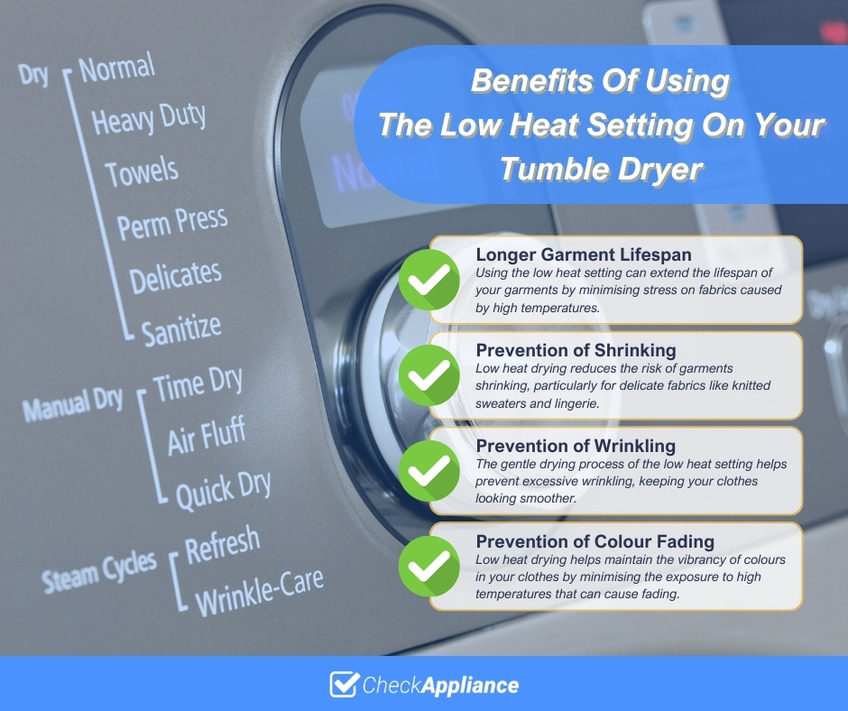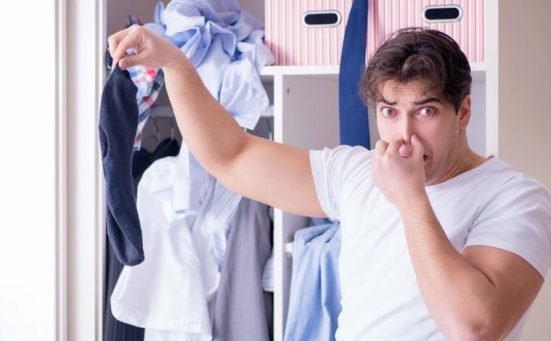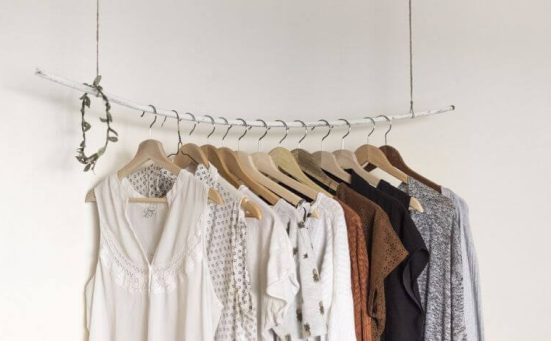
What’s The Lowest Heat Setting On A Tumble Dryer?
The best way to get your laundry dry fast is by using a tumble dryer. Not only is it typically the fastest way to dry your clothes, it’s also the most convenient way too.
Many people like to rely on air drying to get their laundry dry and that’s fine. However, there are certain times of the year when line drying isn’t really practical due to bad weather.
At those times you need to find another way to get your laundry dry and the tumble dryer is often the best solution.
When checking the care label on your clothes many will say low heat only, but what does that mean?
If this is a question you’ve often asked, keep reading because in this article we look at the lowest heat setting on a tumble dryer and explain exactly what it is, when to use it and how to use it.
How Do Tumble Dryers Work?
You probably already know how a tumble dryer works but we’ll explain it anyway to clear up any misconceptions you might have. When you dry your clothes in a tumble dryer, you are in complete control of the temperature the clothes are exposed to and the length of time they’re subjected to that temperature.
This is often far more efficient than hanging clothes on the line and then relying on the weather to provide the correct circumstances to get them dry.
The tumble dryer forces warm or hot air through the drum as it spins and tumbles your clothes around. The combination of warm air and tumbling motion cause the laundry to release moisture and subsequently dry.
However, not all fabrics can withstand high temperatures which means you should always consult the care label in your clothes before tumble drying.
Once you have ascertained that the garments can be tumbled you’ll need to know which setting to use. In this article we look specifically at the lowest temperature setting on a typical tumble dryer.
What Is The Lowest Temperature Setting On A Typical Tumble Dryer?
There are quite a few tumble dryer manufacturers all making various models. This means there are no end of programmes and cycles to choose from when selecting a tumble dryer to suit your needs.
One setting that almost all tumble dryers share is the low heat setting and although this can vary from make to make, the low heat temperature ranges from around 49 to 51 C (120 to 125 F). All you need to know really is that selecting the low heat option will always mean your clothes are never heated above 51 C (125 F).
Why Use The Low Heat Setting On A Tumble Dryer?

There are many fabrics that cannot withstand any temperatures above what’s considered low heat on a tumble dryer. Items like;
- Knitted Sweaters
- Lingerie
- Gym Wear
- Sportswear
- Down Coats
- Embellished Fabrics
- Sheer Fabrics
Using the low heat setting is advised for all of the above. But if you want your clothes to last, it’s a good idea to use the low heat setting for most items of clothing.
Clothes subjected to too high temperatures can shrink, wrinkle and suffer from colour fade. We recommend drying items using the low heat setting whenever possible. They may take longer to dry, but they will last longer too.
You should also be aware that some fabrics can be tumbled on the no heat setting. This is different to the low heat setting and you should never dry no heat items on low heat as they will almost certainly become damaged if you do.
The no heat setting is also good for refreshing certain items between washes or reviving the fluffiness of pillows or blankets for example.
Ways To Ensure Items Dry Faster Using The Low Heat Setting

Obviously, using the low heat setting can mean clothes take a long time to dry. However, there are a few things you can do to ensure that the drying time is kept to a minimum. These include;
Regularly Cleaning The Lint Filter
If the lint filter becomes clogged due to being full of lint, the dryer will not be able to force as much heat through the drum as it is intended to. This means your clothes will take longer to dry or in some cases the appliance will stop working altogether.
You need to remove the filter and clean it after every use to prevent this becoming a problem and to maintain your dryer. Simply hold the filter under fast running water and remove all of the fluff, lint and dirt.
As soon as the water is running freely through the filter, it can be replaced into the dryer. If after washing, the filter remains clogged, you might need to replace the filter.
Ensure The Water Reservoir Is Emptied Regularly
If you own a condenser dryer, you will need to ensure that the water reservoir is emptied after each use. If not, the water extracted from your clothes has nowhere to go and remains in the drum with the laundry.
Ensure The Moisture Sensor Is Clean
If the moisture sensor gets dirty, it cannot detect whether the clothes are wet or dry and this can slow down the drying process or even stop the dryer from running.
You can find the moisture sensor just inside the drum. If it is dirty you should clean it using distilled white vinegar. Apply the white vinegar to a soft cloth and gently wipe the sensor.
Allow the sensor to completely dry before reusing your dryer.
Only Load The Drum To A Maximum Of 3/4
Tumble dryer manufacturers recommend that the drum of the appliance should never be more than ¾ full. We have found that filling the drum anywhere between 50 to 75% keeps the appliance running at its best.
Use Wool Dryer Balls
Adding wool dryer balls to the drum with your laundry can reduce drying times by around 30%. This is because they increase the flow of air around your laundry, speeding up the drying time.
The great thing about wool dryer balls is they are reusable, natural and environmentally friendly too.
Ensure The Vent Is Free From Obstruction
If you own a vented tumble dryer, you need to check the vent regularly and remove any buildup of lint. The dryer works at its best when the vent is free of any obstruction.
Lint builds up in the vent and vent hose and needs to be removed frequently.
Give Your Laundry An Extra Spin
Before transferring your laundry from the washing machine to the tumble dryer, give it an extra spin. This ensures as much water as possible is removed allowing the dryer to get your clothes dry faster.
SEE ALSO: Does The Tumble Dryer’s “Capacity” Mean Dry Or Wet Laundry?
Frequently Asked Questions
The synthetics setting on a tumble dryer does produce low heat.
No, the cotton setting on a tumble dryer is typically the highest heat setting.
It’s better to have the tumble dryer on the low heat setting. This saves money, reduces the risk of a fire breaking out in your dryer and reduces damage to your clothes.
The delicate setting on a dryer is the low heat setting.
Lower heat is better when tumble drying to prevent any damage to your clothes. It also saves on electricity costs and reduces the risk of fire.
It is cheaper to run a dryer on low heat because even though the appliance is running for longer, it uses less electricity.
Clothes are less likely to shrink at lower washing and drying temperatures. This is not an absolute certainty, some garments may still shrink even at lower temperatures which is why you should always consult the wash care label in each individual garment.




